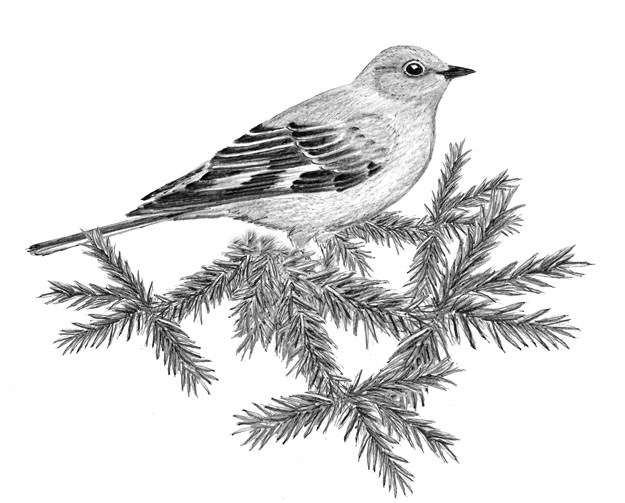
Dear Bird Folks,
I read in your recent column about a rare Northern Wheatear that was seen in Orleans (MA). I ran out to look for it, but the bird seems to have moved on. Now I’m hearing that a Townsend’s Solitaire was spotted in Truro (MA). How long do you think it will stay there? Should I bother making the long drive?
– Dan, Providence, RI
Probably not, Dan,
I hate to sell myself short, but this column is not CNN or some other place to find breaking news. There is a considerable lag between the time I receive a question, do the countless hours of research, formulate an answer, send the manuscript to the Smithsonian for notarization and then submit it for printing in the newspaper. By the time all of those steps take place, the bird in question usually has moved on, or has died of old age. A better way to find updated local birding info is to punch up: http://groups.yahoo.com/group/capecodbirds/. If you aren’t in the mood to type all that, Google “Cape Cod bird sightings” and click away. In the meantime, I’ll tell you a little bit about the Townsend’s Solitaire, just to prove that writing to me wasn’t a total waste of your time.
Usually, when I write about a rare bird, I use adjectives such as “handsome,” “stunning,” or “gorgeous,” but you won’t hear me make such claims about the Townsend’s Solitaire. This bird is kind of dull. In fact, its most interesting feature is its name. Townsend’s Solitaire sounds like a mysterious bird from some exotic place. Nope. Townsend’s Solitaires are fairly common birds that live throughout the western half of the U.S. What makes this dull bird in Truro bird so special, you ask? Well, it’s rare…at least around here. There have only been a handful of Townsend’s Solitaire sightings ever in Massachusetts. Ordinarily, an unusual bird such as this would make a bigger media splash, but it didn’t hang around long enough for everyone to get excited about it. Plus, it’s kind of dull. (Have I mentioned that yet?) The bird wasn’t even discovered until 1835, over three decades after Lewis and Clark traveled west, specifically looking for new species of wildlife. It appears that Lewis and Clark were too busy discovering the Lewis’s Woodpecker and the Clark Bar and they totally missed seeing all the Townsend’s Solitaires around them.
Superficially, solitaires look as if they are a catbird/mockingbird mix, but without the vocal skills. They are actually in the thrush family, but again, without the vocal skills. It would be fun to report that the Townsend’s Solitaire is named after the rock star Pete Townsend, of The Who, but no such luck. Heck, I’d even be happy to tell you that the bird was named after the guy who invented card games for people with no friends, but once again, no. The Townsend’s Solitaire is actually named after John Kirk Townsend, a hard luck naturalist of the early 1800s. JK Townsend was born in Philadelphia, but he spent much of his time collecting and studying western birds. Well, he studied birds as best he could, but sometimes other people made things difficult for him. More than once Townsend returned to his campsite to find that his traveling companions had drunk all of the special alcohol he needed for preserving his specimens. On another occasion he collected an unusual owl, but before he could preserve and study the strange bird, one of his fellow naturalists cooked and ate the owl, and then washed it down with the preservative alcohol. Finally, Townsend started using a “secret powder” to preserve his specimens. Unfortunately, the powder contained arsenic and it killed him. Poor JKT…he would have been better off if he had earned his living inventing card games.
Even though the Townsend’s Solitaire has nothing to do with solo card games, the bird is actually a good candidate to play one of those games. A flock of Townsend’s Solitaires usually consists of one bird. Except when breeding, they tend to avoid all birds, including each other. In the summer solitaires can be found in the higher altitudes, feeding on insects. But in the winter they move to lower elevations, where they survive on berries. Berry patches are critical areas for these birds and they defend them against all comers. Violent skirmishes break out whenever another solitaire comes too close to a claimed territory. More often than not, the intruder is an immature bird and it is forced away. The young bird then must try to survive the winter eating nothing but boxes of Ramen Noodles, and that gets old after a while.
Compared to the seasonal migrations made by other birds, solitaires make fairly short trips. Some solitaires stay put all winter, while others only travel a few hundred miles. That’s why finding one of these birds in Massachusetts is such a treat for birders. How did a bird, which was trying to go from the mountains of Colorado to the plains of Nebraska, end up in Truro? There are a lot of theories about that, but most likely the bird was born with a messed up internal navigation system. Either that or it was using the new map app in the iPhone 5. Everybody gets lost using that.
From what I can tell, Dan, the Townsend’s Solitaire only stayed in Truro for two days. It guess Truro, in the off-season, was just too boring for the Townsend’s Solitaire. And that’s saying something, especially for a bird that was planning to spend its winters in Nebraska.